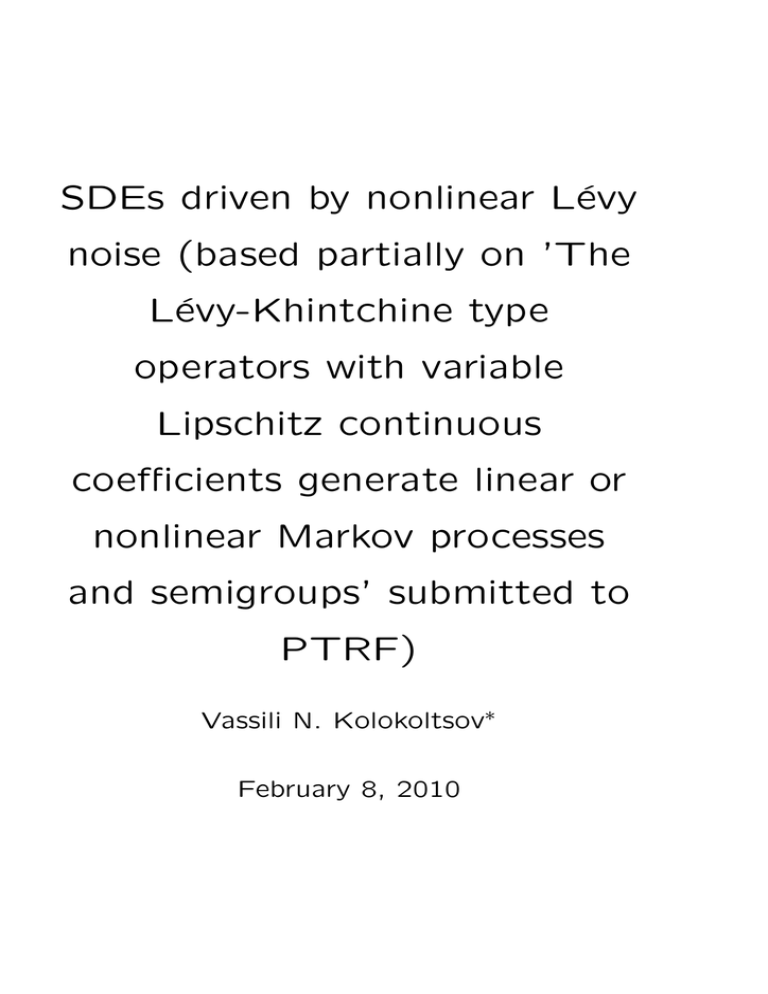SDEs driven by nonlinear L´ evy noise (based partially on ’The L´
advertisement

SDEs driven by nonlinear Lévy
noise (based partially on ’The
Lévy-Khintchine type
operators with variable
Lipschitz continuous
coefficients generate linear or
nonlinear Markov processes
and semigroups’ submitted to
PTRF)
Vassili N. Kolokoltsov∗
February 8, 2010
PLAN:
1) What is ’SDEs driven by nonlinear Lévy
noise’ ? How usual SDEs (with and without
jumps) fit to this general scheme?
2) Main motivation: ’The Lévy-Khintchine
type operators with variable Lipschitz continuous coefficients generate linear or nonlinear
Markov processes and semigroups’: Reconciling the theory of SDEs with the theory of
Markov semigroups.
3) Example of further applications: curvilinear OU processes
SDEs DRIVEN BY NONLINEAR LÉVY
NOISE
dXt = dYt(Xt) ⇐⇒ Xt = x +
Z t
0
dYs(Xs) ds.
(1)
or more generally
dXt = dYt(Xt, L(Xt))
⇐⇒ Xt = x +
Z t
0
dYs(Xs, L(Xs)) ds,
where L(ξ) denotes the law of a r.v. ξ and
where Yt(z, µ) is a family of Lévy processes
specified by their generators
1
L[z, µ]f (x) = (G(z, µ)∇, ∇)f (x)+(b(z, µ), ∇f (x))
2
Z
+
(f (x + y) − f (x) − (∇f (x), y))ν(z, µ; dy).
One can construct solutions from the Euler
type approximation scheme. For instance,
take equation (1). Let Yτl (x) be a collection
(depending on l = 0, 1, 2, ...) of independent
families of the Lévy processes Yτ (x) depending measurably on x. Define the approximations X µ,τ by:
µ,τ
Xt
µ,τ
µ,τ
l
= Xlτ + Yt−lτ
(Xlτ ),
L(Xµτ (0)) = µ,
for lτ < t ≤ (l + 1)τ , where L(X) means the
probability law of X.
Stochastic equation of the standard form
Xt = x +
+
Z t
0
Z tZ
0
σ(Xs−)dBs +
Z t
0
b(Xs−)ds
F (Xs−, y)Ñ (dsdy),
where F is a measurable mapping Rn × Rd 7→
Rn and σ maps Rn to n × d-matrices and
Ñ (dsdx) is the corresponding compensated
Poisson measure of jumps of the Lévy process Y with the generator
Z
Lf (x) = +
having
R
[f (x+y)−f (x)−(y, ∇)f (x)]ν(dy),
|y|2ν(dy) < ∞.
It complies with the above general scheme for
Yt(z) = σ(z)Bt + b(z)t +
Z tZ
0
F (z, y)Ñ (dsdy).
(2)
Unlike the general case the processes Yt are
given as functionals of a single process.
MARKOV PROCESSES WITH A GIVEN
GENERATOR
It is well known (the Courrège theorem) that
the generator L of a conservative (i.e. preserving constants) Feller semigroup in Rd is
conditionally positive (f ≥ 0, f (x) = 0 =⇒
Lf (x) ≥ 0) and if its domain contains the
space Cc2(Rd), then it has the following LévyKhintchine form with variable coefficients:
1
Lf (x) = (G(x)∇, ∇)f (x) + (b(x), ∇f (x))
2
Z
(f (x+y)−f (x)−(∇f (x), y)1B1 (y))ν(x, dy),
+
(3)
where G(x) is a symmetric non-negative matrix and ν(x, .) a Borel measure on Rd (called
Lévy measure) such that
Z
Rn
min(1, |y|2)ν(x; dy) < ∞,
ν({0}) = 0.
(4)
The inverse question on whether a given operator of this form (or better to say its closure) actually generates a Feller semigroup is
nontrivial and attracted lots of attention.
Theorem 1 Under the assumption
·
q
q
tr( G(x1) −
G(x2))2
¸1/2
+ |b(x1) − b(x2)|
+W2(ν(x1, .), ν(x2, .)) ≤ κ2kx1 − x2k.
(5)
(i) for any µ ∈ P(Rd) ∩ M2(Rd) there exists a
µ
µ,τ
limit process Xt for the approximations Xt
such that
µ
µ,τ
µ
sup sup W22 X[s/τk ]τ , Xt
k k
µ
¶
s∈[0,t]
≤ c(t)τk ,
and even stronger
2
sup W2,t,un
(X µ,τk , X µ) ≤ c(t)τk ,
µ
µ
(ii) the distributions µt = L(Xt ) depend 1/2Hölder continuous on t in the metric W2 and
Lipschitz continuously on the initial condition:
µ
η
W22(Xt , Xt ) ≤ c(T )W22(µ, η);
(iii) the processes
µ
M (t) = f (Xt ) − f (x) −
are martingales for any f ∈
Z t
(Lf (Xsµ) ds
0
C 2(Rd),
where
1
Lf (x) = (G(x)∇, ∇)f (x) + (b(x), ∇f (x))
2
Z
+
[f (x + y) − f (x) − (y, ∇)f (x)]ν(x, dy),
µ
in other words, the process Xt solves the corresponding martingale problem;
(iv) the operators Ttf (x) = Ef (Xtx) form a
conservative Feller semigroup preserving the
space of Lipschitz continuous functions and
2 (Rd ),
with the domain of generator containing C∞
where it is given by (3).
CURVILINEAR OU PROCESSES
The analog of the free motion ẋ = p, ṗ =
0 on a Riemannian manifold (M, g) is called
the geodesic flow on M and is defined as the
Hamiltonian system on the cotangent bundle
T ?M specified by the Hamiltonian
1
(G(x)p, p), G(x) = g −1(x),
2
describing the kinetic energy in a curvilinear
space, the geodesic flow equations being
H(x, p) =
ẋ = G(x)p
1 ∂G
ṗ = − (
p, p)
2 ∂x
(6)
In physics, stochastics often appears as a model
of heat bath obtained by adding a homogeneous noise to the second equation of a
Hamiltonian system, i.e. by changing the
above to
∂H
ẋ =
∂p
(7)
∂H
dp = −
dt + dYt,
∂x
where Yt is a Lévy process. In the most studied models Yt stands for the BM with the variance proportional to the square root of the
temperature. To balance the energy pumped
into the system by the noise, one often adds
friction to the system, i.e. a non conservative
force proportional to the velocity. In case of
initial free motion this yields the system
(
ẋ = p
dp = −αp dt + dYt
(8)
with a nonnegative matrix α, called the OrnsteinUhlenbeck (OU) system driven by the Lévy
noise Yt. Especially well studied are the cases
when Yt is BM or a stable process.
If a random force is not homogeneous, as
should be the case on a manifold or in a nonhomogeneous media, one is led to consider
Yt to be a family of processes depending on
the position x ∈ M leading naturally to SDEs
studied above. In particular, the curvilinear
analog of the OU system is the process in
T ?M specified by the equation
∂H
ẋ
=
∂p
(9)
∂H
dp = −
dt − α(x)p dt + dYt(x)
∂x
where H(x, p) = (G(x)p, p)/2. Assuming for
simplicity that all Yt are zero mean Lévy processes with the Lévy measure being absolutely continuous with respect to the invariant
Lebesgue measure on Tx?M and having finite
R
outer first moment ( |y|>1 |y|ν(dy) < ∞), the
generator of Yt can be written in the form
LxY f (p) =
Z
+
1
(A(x)∇, ∇)f (p)
2
(det G(x))1/2dq
[f (p + q) − f (p) − ∇f (p)q]
ω(x, q)
with a certain positive ω(x, q). Hence the corresponding full generator of the process given
by (9) has the form
Lf (x, p) =
∂H ∂f
∂H ∂f
∂f
−
− (α(x)p,
)
∂p ∂x
∂x ∂p
∂p
Ã
1
+ tr A(x)
2
Z
+
∂ 2f(x, p)
!
∂p2
∂f (x, p) (det G(x))1/2dp
q]
.
[f (x, p+q)−f (x, p)−
∂p
ω(x, p)
Of course in order to have a true system on
a manifold, this expression should be invariant under the change of coordinate, which
requires certain transformation rules for the
coefficient α, A, ω. This issue is settled in the
next statement.
Proposition 1 Operator L is invariant under
the change of coordinates
µ
¶
∂x T
x 7→ x̃, p 7→ p̃ =
p,
∂x̃
if and only if ω is a function on T ?M , α is
(1, 1)-tensor and A is a (0, 2)-tensor, i.e.
ω̃(x̃, p̃) = ω(x(x̃), p(x̃, p̃)),
µ
¶
µ
¶
∂x T
∂x̃ T
α̃(x̃) =
α(x(x̃))
,
∂x̃
∂x
µ
¶T
∂x
∂x
Ã(x̃) =
A(x(x̃)) .
∂x̃
∂x̃
(10)
Of particular interest are processes depending only on the Riemannian structure. For
instance (9) defines the curvilinear OU process of diffusion type if Yt has the generator
1
= (g(x)∇, ∇)f (p)
2
and of the β- stable type, β ∈ (0, 2), if Yt has
the generator
LxY f (p)
LxY f (p)
Z
=
[f (p+q)−f (p)−∇f (p)q]
(det G(x))1/2dq
(q, G(x)q)(β+1)/2
.
An alternative way to extend OU processes
to manifolds is via embedding to Euclidean
spaces. Namely, observe that one can write
∂ xdY in Rn meaning that adding a
dYt = ∂x
t
Lévy noise force is equivalent to adding the
singular nonhomogeneous potential −xẎt (position multiplied by the noise) to the Hamiltonian function. Assume now that a Riemannian manifold (M, g) is embedded to the
Euclidean space Rn via a smooth mapping
r : M 7→ Rn and that the random environment in Rn is modeled by the Lévy process
Yt. The position of a point x in Rn is now
r(x) so that the analog of xYt is the product
r(x)Yt, and the term Yt from (7) should have
as the curvilinear modification the term
µ
¶
n
X
∂r T
∂r j
j d
dYt = {
dY
t }i=1 ,
i
∂x
j=1 ∂x
that yields the projection of the ’free noise’
Yt on the cotangent bundle to M at x.
In particular, the stochastic (or stochastically
perturbed) geodesic flow induced by the embedding r can be defined by the stochastic
system
ẋ = G(x)p
µ
¶T
(11)
∂G
∂r
1
dp = − (
p, p)dt +
dYt
2 ∂x
∂x
which represents simultaneously the natural
stochastic perturbation of the geodesic flow
(6) and the curvilinear analog of the stochastically perturbed free motion ẋ = p, dp = dYt.



